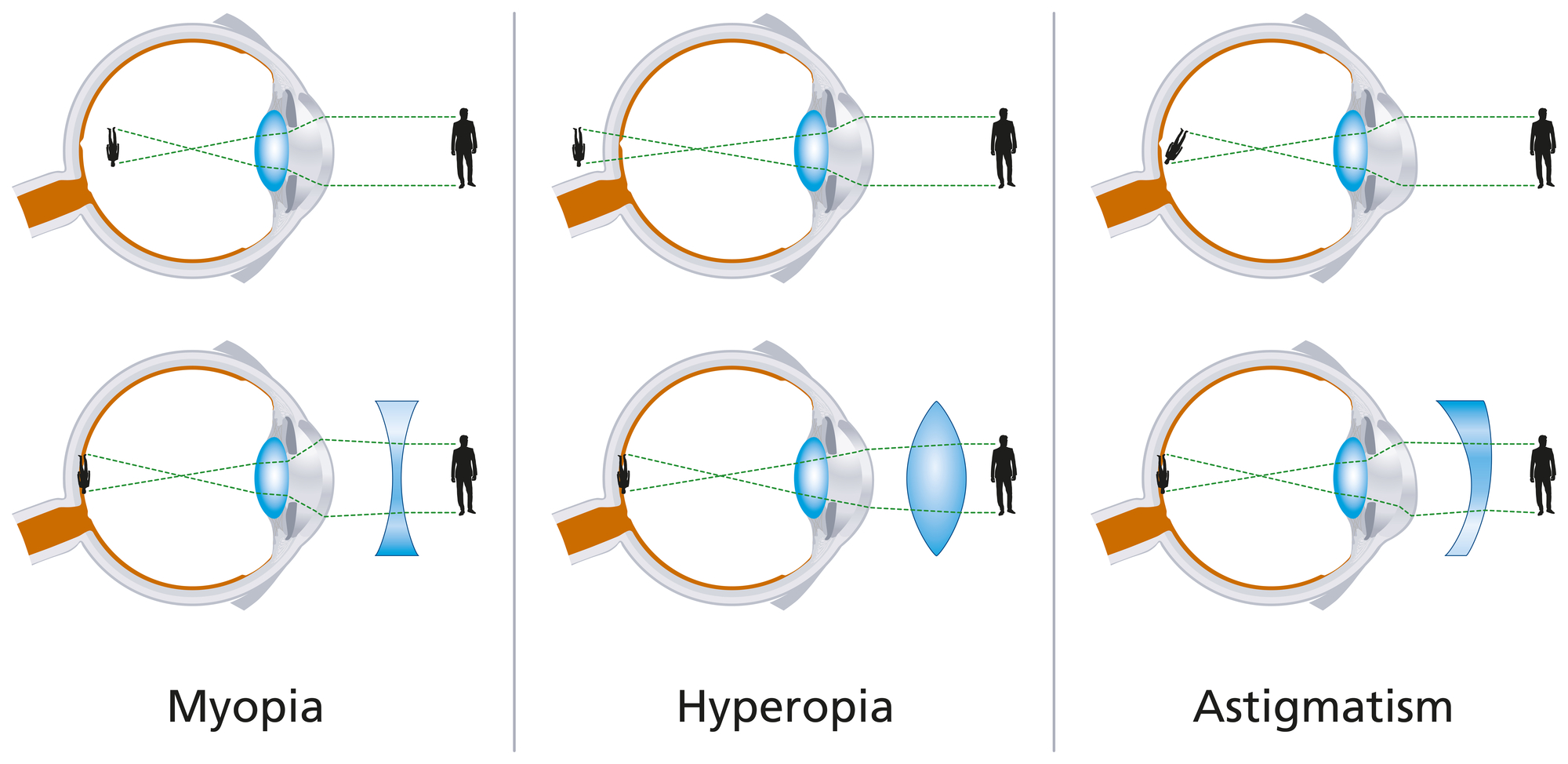Updated on October 21, 2024
LASIK for Nearsightedness (Myopia)


Vision Center is funded by our readers. We may earn commissions if you purchase something via one of our links.
Can LASIK Correct Nearsightedness?
Laser eye surgery, or LASIK, is a vision correction procedure that reshapes the cornea. People with refractive errors may opt for LASIK surgery to correct vision problems like nearsightedness.

Laser eye surgery aims to help people achieve clear vision. Many people report improved vision and greater independence from corrective lenses after laser surgery.
How Does LASIK Correct Nearsightedness?
After a preoperative consultation, your doctor will tell you if you are suitable for LASIK treatment.
Essentially, here’s how LASIK eye surgery corrects nearsightedness:
- Creating a flap on the outer layer of the eye
- Using lasers to reshape the cornea and correct the refractive error
LASIK Procedure for Nearsightedness

A LASIK procedure includes the following steps:
- The surgeon will create a thin flap on the cornea with the femtosecond laser or microkeratome blade.
- Once they create the flap, the surgeon will open it to access the cornea and remove some corneal tissue. They’ll do this by using an excimer laser.
- The surgeon will flatten the cornea to correct the nearsightedness. Excimer lasers also correct astigmatism by smoothing the irregular-shaped cornea.
- After reshaping the cornea, the surgeon will close the flap back in place.
What Is Nearsightedness?
Nearsightedness, or near vision, is a vision problem where you can only see objects clearly when they are up close. This occurs when the shape of the eye causes light rays to bend and refract incorrectly.
As a result, you experience blurred vision when you look at objects that are far away. Nearsightedness is also known as myopia.
Wearing glasses and/or contact lenses can correct common refractive errors like nearsightedness and farsightedness. However, LASIK is a more effective, long-term solution.
Am I a Good Candidate for LASIK?
To check if your nearsightedness qualifies for LASIK treatment, it’s always best to consult your doctor first. They will evaluate multiple factors before recommending LASIK eye surgery to you.
Refractive errors are measured in diopters. A diopter is a unit used to denote the strength of the eye’s natural lens.
To qualify for modern LASIK surgery, you must have one of the following nearsightedness prescriptions:
- Up to -12.0 diopters of nearsightedness, with or without astigmatism
- The amount of nearsightedness with or without astigmatism did not change by 0.5 diopters within the year before your operation
Other Factors to Consider
Aside from this numerical value, your doctor will also check for and ask about other factors like:
Cornea Thickness
During laser surgery, the surgeon must create a flap on your cornea by removing some of your cornea tissue. This means you need to have a thick cornea for this surgical procedure. A thin cornea will make the surgery risky.
Stability of Prescription
Laser eye surgery will only be successful if you’ve had a stable prescription for a year. If you have an unstable prescription, there’s a high chance your vision will change immediately after laser surgery.
Overall Eye Health
You must be free from eye disease when receiving laser eye surgery. For instance, many people with cataracts may not be a good candidate for treatment. They may need to undergo cataract surgery first before LASIK.
Pregnancy or Lactation
While LASIK can correct nearsightedness and farsightedness during pregnancy, it’s best to wait until afterward. The procedure can cause complications for the baby and the mother.
LASIK Recovery Tips
Once the LASIK procedure is complete, it’s essential to rest. Someone also needs to drive you home. You may be able to drive the next day, depending on your vision and how you feel.
During the recovery stage, a person who underwent LASIK must:
- Avoid any strenuous exercise for a week because this can affect healing
- Return to the eye surgeon the day after surgery
- Follow the doctor’s instructions
- Take the prescribed medication to prevent healing problems
What to Expect After Surgery
After LASIK surgery, you can expect the following:
- A temporary burning or itching sensation in the eyes
- Slightly blurry vision and haziness. This is temporary, and vision should be clear the next day.
- Your eyesight to be stable after a few days. In rare cases, this takes weeks, but for most people, vision improves immediately.
LASIK results may vary. Most people who have undergone surgery achieve the normal distance vision of 20/20.
Possible Side Effects and Risks of LASIK
LASIK surgery is a very safe procedure if done correctly. There are no reported cases of vision loss directly from LASIK.
However, you should still be aware of the possible side effects and risks of LASIK, such as:
- Dry eyes
- Hazy vision
- Double vision
- Under- or over-correction of the vision
- Glare, halos, or starbursts around lights
- Corneal infection or inflammation
- Flap complications, such as displacement of the flap after surgery
Remember to follow your surgeon’s aftercare instructions during the healing process to prevent vision issues.
Listen In Q&A Format
What You Should Know About LASIK for Nearsightedness Myopia
Vision Center Podcast
Are LASIK Eye Surgery Results Permanent?
Despite having an excellent safety record, LASIK complications can still occur. Some people need a LASIK enhancement or touch-up a few months after the first surgery to achieve good visual acuity.
In addition, LASIK won’t prevent or stop presbyopia development. Presbyopia, or age-related farsightedness, can make it difficult to see things up close. This means you may need to wear reading glasses eventually, even after undergoing a successful vision correction procedure.
It’s important to discuss any concerns with your surgeon before deciding to have laser eye surgery. Make sure you’ve asked about all the pros and cons.
How Much Does LASIK Cost?
In 2021, the average cost for LASIK in the United States was about $2,246 per eye.
Pricing is set by surgeons frequently performing LASIK and other laser eye procedures such as PRK, SMILE, and refractive lens exchange.
The technology your surgeon uses also impacts the total cost of LASIK. Different technologies include:
- Excimer laser to reshape the cornea
- Bladeless LASIK that uses a femtosecond laser to create the flap
- All-laser treatment
- Custom LASIK treatment
Is LASIK Worth It?
LASIK treatment is pricey. But if you buy glasses or contact lenses every year or every six months, LASIK surgery will save you money in the long run.
Before committing to LASIK surgery, make sure you have discussed the risks and itemized costs with your surgeon. Always read the fine print and check if there are hidden charges beforehand.
Beware of LASIK procedures that advertisers market at low prices. If a procedure cost seems too good to be true, it probably is.
Cheap LASIK advertisements usually don’t mention that the:
- Treatment is for mild nearsightedness only
- Price doesn’t cover all of the fees
- Procedure might be performed using old technology
- Surgeon is less experienced
Summary
LASIK is a safe, effective procedure for correcting nearsightedness. Most people who have undergone surgery achieve the normal distance vision of 20/20.
However, you should be aware of the possible risks associated with LASIK. If you have any concerns, discuss them with your surgeon before the procedure.
In this article
6 sources cited
Updated on October 21, 2024
Updated on October 21, 2024
About Our Contributors
Vincent Ayaga is a medical researcher and seasoned content writer with a bachelor's degree in Medical Microbiology. Specializing in disease investigation, prevention, and control, Vincent is dedicated to raising awareness about visual problems and the latest evidence-based solutions in ophthalmology. He strongly believes in the transformative power of ophthalmic education through research to inform and educate those seeking knowledge in eye health.
Dr. Melody Huang is an optometrist and freelance health writer with a passion for educating people about eye health. With her unique blend of clinical expertise and writing skills, Dr. Huang seeks to guide individuals towards healthier and happier lives. Her interests extend to Eastern medicine and integrative healthcare approaches. Outside of work, she enjoys exploring new skincare products, experimenting with food recipes, and spending time with her adopted cats.

